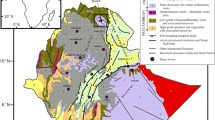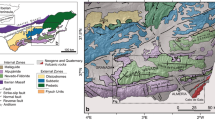Abstract
The Lebanese Restraining Bend is 170 km long and lies obliquely along the N-S trending Dead Sea Transform Fault, which is the continental plate boundary between Arabia and Africa. Of particular attention about the Lebanese Restraining Bend is the presence of two basins in its southern and northern bounds that are bordered by basalts; these are the Hula basin and the Bouqayaa basin, respectively. These two basins and the presence of basalts in their vicinities raise questions about (1) their locations in the immediate proximity to a transpressive bend, (2) the tectonic interrelation between the formation of the basins and the emplacement of the basalts, and (3) the timing of the formation of the basins relative to the prevailing regional transpression. In this paper, the author sheds light on these aspects and proposes a simplistic kinematic model of the tectonics behind the transpressive regime, the formation of the basins, and the emplacement of the basalts. The presented model highlights the tectonic interrelation between the formation of the basins, their bordering basalts, and the deformation of the transpressive bend. The regional strike-slip movements along the faults outside and within the transpressive bend seem to have caused co-existing extensional and compressional regimes, and they suggest that the formation of the basins may be contemporaneous with the regional transpression. The results can serve as a conceptual model for more advanced boundary-element modeling and finite-element modeling of the tectonics of the Lebanese Restraining Bend, with potential broader insight into the understanding of the tectonics of transpressive bends and their interrelation with adjacent extensional basins, worldwide.







Similar content being viewed by others
References
Abdel-Rahman AM, Kallas LM (2013) Insights from the basalts of SE Lebanon into the nature of the Middle East Cenozoic volcanic province. Neues Jahrb Geol Palaontol Abh 270(2):209–232
Abdel-Rahman AM, Nassar PE (2004) Cenozoic volcanism in the Middle East: petrogenesis of alkali basalts from northern Lebanon. Geol Mag 141:545–563
Abdul-Wahed K, Asfahani J, Al-Tahhan I (2011) A combined methodology of multiplet and composite focal mechanism techniques for identifying seismologically active zones in Syria. Acta Geophysica 59(5):967–992
Adiyaman O, Chorowicz J (2002) Late Cenozoic tectonics and volcanism in the northwestern corner of the Arabian plate: a consequence of the strike-slip Dead Sea fault zone and the lateral escape of Anatolia. J Volcanol Geotherm Res 117:327–345
Almond DC (1986) Geological evolution of the Afro-Arabian Dome. Tectonophysics 131:301–332
Bertrand H, Chazot G, Blichert-Toft J, Thoral S (2003) Implications of widespread high-μ volcanism on the Arabian Plate for Afar mantle plume and lithosphere composition. Chem Geol 198:47–61
Brew G, Barazangi M, Al-Maleh AK, Sawaf T (2001) Tectonic and geologic evolution of Syria. GeoArabia 6:573–616
Butler RW, Spencer S, Griffiths HM (1997) Transcurrent fault activity on the Dead Sea Transform in Lebanon and its implications for plate tectonics and seismic hazard. J Geol Soc Lond 154:757–760
Camp VE, Roobol MJ (1992) Upwelling asthenosphere beneath western Arabia and its regional implications. J Geophys Res 97B:15255–15271
Chorowicz J, Dhont D, Ammar O, Rukieh M, Bilal A (2005) Tectonics of the Pliocene Homs basalts (Syria) and implications for the Dead Sea Fault Zone activity. J Geol Soc Lond 162:259–271
Daeron M, Klinger Y, Tapponnier P, Elias A, Jacques E, Sursock A (2005) Sources of the large A. D. 1202 and 1759 Near East earthquakes. Geology 33:529–532
Diner J (2019) Failed rifting in Jordan and the development of the Dead Sea Transform. J Geodyn 124:104–118. https://doi.org/10.1016/j.jog.2019.01.013
Dubertret L (1955) Carte géologique du Liban au 1:200,000 avec notice explicative. République Libanaise, Ministère des travaux publics
Dubertret L (1962) Carte géologique du Liban, Syrie, et bordure des pays voisins au 1:1,000,000. Muséum National d’Histoire Naturelle, Paris
Garfunkel Z (1989) Tectonic setting of Phanerozoic magmatism in Israel. Isr J Earth Sci 38:51–74
Gomez F, Meghraoui M, Darkal AN, Hijazi F, Mouty M, Suleiman Y, Sbeinati R, Darawcheh R, Al-Ghazzi R, Barazangi M (2003) Holocene faulting and earthquake recurrence along the Serghaya branch of the Dead Sea fault system in Syria and Lebanon. Geophys J Int 153:658–674
Gomez F, Karam G, Khawlie M, McClusky S, Vernant P, Reilinger R, Jaafar R, Tabet C, Khair K, Barazangi M (2007) Global Positioning System measurements of strain accumulation and slip transfer through the restraining bend along the Dead Sea fault system in Lebanon. Geophys J Int 168:1021–1028
Gomez F, Cochran WJ, Yassminh R, Jaafar R, Reilinger R, Floyd M, King RW, Barazangi M (2020) Fragmentation of the Sinai Plate indicated by spatial variation in present-day slip rate along the Dead Sea Fault System. Geophys J Int 221:1913–1940
Goren L, Castelltort S, Klinger Y (2015) Modes and rates of horizontal deformation from rotated river basins: application to the Dead Sea fault system in Lebanon. Geology 43(9):843–846. https://doi.org/10.1130/G36841.1
Guba I, Mustafa H (1988) Structural control of young basaltic fissure eruptions in the plateau basalt area of the Arabian Plate, northeastern Jordan. J Volcanol Geotherm Res 35:319–334
Hofstetter R, Klinger Y, Amrat AQ, Rivera L, Dorbath L (2007) Stress tensor and focal mechanisms along the Dead Sea fault and related structural elements based on seismological data. Tectonophysics 429:165–181
Krienitz MS, Haase KM, Mezger K, van den Bogaard P, Thiemann V, Shaikh-Mashail MA (2009) Tectonic events, continental intraplate volcanism, and mantle plume activity in northern Arabia: constraints from geochemistry and Ar-Ar dating of Syrian lavas. Geochem Geophys Geosyst 10(4):1–26
Lachenbruch AH, Sass JH, Galnis SP Jr (1985) Heat flow in southernmost California and the origin of the Salton Trough. J Geophys Res Solid Earth 90(B8):6709–6736. https://doi.org/10.1029/JB090iB08p06709
Lustrino M, Sharkov E (2006) Neogene volcanic activity of western Syria and its relationship with Arabian plate kinematics. J Geodyn 42:115–139
Mart Y (1991) The Dead Sea Rift: from continental rift to incipient ocean. Tectonophysics 197:155–179
McKenzie D, Bickle MJ (1988) The volume and composition of melt generated by extension of the lithosphere. J Petrol 29(3):625–679
Meirova T, Hofstetter R (2013) Observations of seismic activity in Southern Lebanon. J Seismol 17:629–644
Mor D (1993) A timetable for the Levant Volcanic Province, according to K-Ar dating in the Golan Heights. Israel Journal of African Earth Sciences 16(3):223–234
Mouty M, Delaloye M, Fontignie D, Piskin O, Wagner JJ (1992) The volcanic activity in Syria and Lebanon between Jurassic and Actual. Schweiz Mineral Petrogr Mitt 72:91–105
Weinstein Y, Nuriel P, Inbar M, Jicha BR, Weinberger R (2020) Impact of the Dead Sea Transform kinematics on adjacent volcanic activity. Tectonics 39:e2019TC005645. https://doi.org/10.1029/2019TC005645
Nemer TS (2019) The Bisri dam project: a dam on the seismogenic Roum fault, Lebanon Engineering Geology 261(2019) 105270. https://doi.org/https://doi.org/10.1016/j.enggeo.2019.105270
Nemer T (2020) Meghraoui M (2020) A non-active fault within an active restraining bend: the case of the Hasbaya fault. Lebanon J Struct Geol 136:104060. https://doi.org/10.1016/j.jsg.2020.104060
Weinstein Y, Navon O, Altherr R, Stein M (2006) The role of lithospheric mantle heterogeneity in the generation of Plio-Pleistocene alkali basaltic suites from Harrat Ash Shaam (Israel). J Petrol 47:1017–1050
Nemer T, Meghraoui M (2006) Evidence of coseismic ruptures along the Roum fault (Lebanon): a possible source for the AD 1837 earthquake. J Struct Geol 28:1483–1495
Nemer T, Meghraoui M, Khair K (2008a) The Rachaya-Serghaya fault system (Lebanon). Evidence of Coseismic ruptures and the AD 1759 earthquake sequence. J Geophys Res 113 B05312. https://doi.org/10.1029/2007JB005090
Nemer T, Gomez F, Al Haddad S, Tabet C (2008b) Coseismic growth of sedimentary basins along the Yammouneh strike-slip fault (Lebanon). Geophys J Int 175(3):1023–1039. https://doi.org/10.1111/j.1365-246X.2008.03889.x
Norris RJ, Toy VG (2014) Continental transforms: a view from the Alpine Fault. J Struct Geol 64:3–31. https://doi.org/10.1016/j.jsg.2014.03.003
Palano M, Imprescia P, Gresta S (2013) Current stress and strain-rate fields across the Dead Sea Fault System: constraints from seismological data and GPS observations. Earth Planet Sci Lett 369-370:305–316
Pearce JA, Norry MJ (1979) Petrogenetic implications of Ti, Zr, Y, and Nb variations in volcanic rocks. Contrib Mineral Petrol 69:33–47
Pondrelli S, Morelli A, Ekström G, Mazza S, Boschi E, Dziewonski AM (2002) European-Mediterranean regional centroid-moment tensors: 1997-2000. Phys Earth Planet Inter 130:71–101
Rybakov M, Fleischer L, ten Brink U (2003) The Hula Valley subsurface structure inferred from gravity data. Isr J Earth Sci 52:113–122
Salamon A, Hofstetter A, Garfunkel Z, Ron H (2003) Seismotectonics of the Sinai subplate - the eastern Mediterranean region. Geophys J Int 155:149–173
Schattner U, Weinberger R (2008) A mid-Pleistocene deformation transition in the Hula basin, northern Israel: implications for the tectonic evolution of the Dead Sea Fault. Geochem Geophys Geosyst 9(7):1–18
Shaw JE, Baker JA, Menzies MA, Thirlwall MF, Ibrahim KM (2003) Petrogenesis of the largest intraplate volcanic field on the Arabian Plate (Jordan): a mixed lithosphere-asthenosphere source activated by lithospheric extension. J Petrol 44(9):1657–1679
Stein M, Hofmann AW (1992) Fossil plume head beneath the Arabian lithosphere? Earth Planet Sci Lett 114:193–209
Acknowledgements
This research was supported by a seed grant from the American University of Beirut, Lebanon. A. Abdel-Rahman is thanked for valuable discussions. Editor-in-Chief Al-Amri, Editor Roure, and two reviewers are thanked for their helpful reviews and suggestions that improved the manuscript.
Author information
Authors and Affiliations
Corresponding author
Ethics declarations
Conflict of interest
The author declares that he has no competing interests.
Additional information
Responsible Editor: François Roure
Rights and permissions
Springer Nature or its licensor (e.g. a society or other partner) holds exclusive rights to this article under a publishing agreement with the author(s) or other rightsholder(s); author self-archiving of the accepted manuscript version of this article is solely governed by the terms of such publishing agreement and applicable law.
About this article
Cite this article
Nemer, T.S. The presence of extensional volcanic basins along a transpressive bend: a case of extension-transpression co-existence from the Lebanese Restraining Bend. Arab J Geosci 16, 129 (2023). https://doi.org/10.1007/s12517-023-11236-0
Received:
Accepted:
Published:
DOI: https://doi.org/10.1007/s12517-023-11236-0




